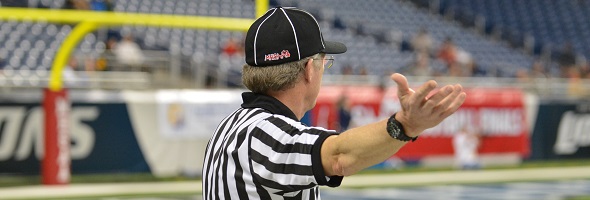
Be the Referee: Spearing
September 3, 2015
This week, MHSAA assistant director Mark Uyl explains the expanded definition of spearing added for football this season.
Be The Referee is a series of short messages designed to help educate people on the rules of different sports, to help them better understand the art of officiating, and to recruit officials.
Below is this week's segment - Spearing - Listen
One of the new changes to the high school football rules for this year is an expanded definition of spearing an opponent with the helmet. With all the attention on player safety and reducing the head-to-head collisions between players, this new definition of illegal helmet contact will better help officials, coaches, players and fans with what is illegal and must be penalized by rule.
Simply put, a spearing foul has taken place when any player hits an opponent with the crown, or top portion, of his helmet as the first point of contact. These fouls where contact has been initiated by a player first with the crown of the helmet must be called and enforced consistently throughout the season.
Past editions:
Aug. 27: Missed Field Goal - Listen

Be the Referee: Soccer Timing
By
Sam Davis
MHSAA Director of Officials
September 20, 2022
Be The Referee is a series of short messages designed to help educate people on the rules of different sports, to help them better understand the art of officiating, and to recruit officials.
Below is this week's segment – Soccer Timing - Listen
One of the biggest complaints people make about professional soccer is never knowing how much time is really left in the game. The clock counts up from zero, and the referee can add time at their discretion.
But that’s not the case in high school soccer.
To start with, halves are 40 minutes, not 45. The clock starts at 40 and counts down. And when players are injured and the ball is not in play, the clock will stop and then restart when action is ready to continue.
In the last five minutes of the game, the clock stops for substitutions by the leading team, so a coach can’t stall by sending in a new player. When the clock hits zero and the buzzer sounds … the game is over. There’s no guessing how much added time there is – the end of the game is the end of the game.
Previous Editions:
Sept. 13: Volleyball Replays - Listen
Sept. 6: Switching Sides - Listen
Aug. 30: Play Clock - Listen
Aug. 23: Intentional Grounding Change - Listen

